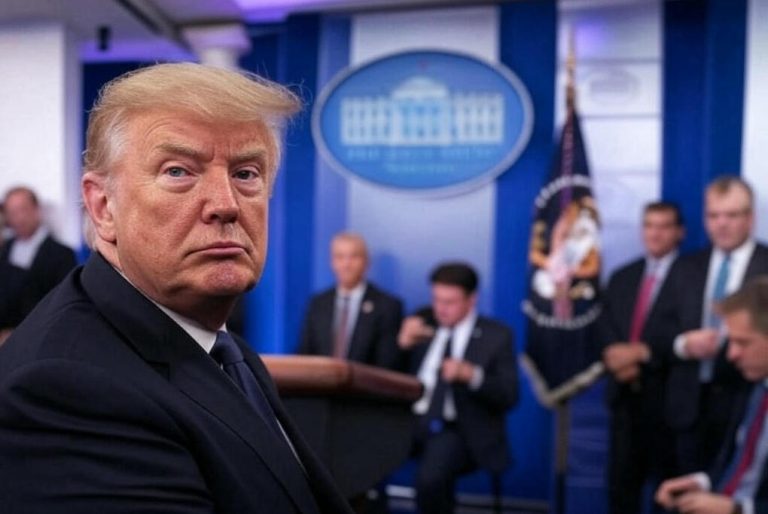The Trump administration is not using tariffs for short-term gain or to signal campaign strength.
This time, tariffs are the opening move in a long-term strategy to rewire global trade and build a new economic order.
As Treasury Secretary Scott Bessent puts it:
“Tariffs have begun the process of reorienting our international economic relations.”
But these policies have shocked global markets and confused even America’s closest allies.
Many assume it’s a political theater; or economic chaos. But is there a real plan behind the noise? And does that plan even make sense?
The why
Here are the facts: The US economy remains the world’s largest. Its stock market makes up approximately 50% of global markets.
And most importantly, the dollar is still the global reserve currency.
However, what concerns the current administration is the deep industrial decline of the United States.
Manufacturing made up 28% of US output in the 1950, while today, it’s just below 11%.
Even though most economists argue that the US is now a “service exporter” and that is the reason why its economy is now the largest, the current administration thinks otherwise.
Bessent and Trump’s top economic advisor, Steven Miran, argue that deindustrialization is a national security threat. In the event of a war, civilian industrial capacity is critical.
China’s shipbuilding capacity is now larger than the rest of the world combined.
According to US Vice President J.D. Vance, one of China’s state-owned firms built more commercial ships in 2023 than the US has since World War II.
With the worries of a potential China – Taiwan war rising every year, the US now wants to become the leader in industrial production and
How did we get here?
So why is the US all suddenly against the world trading system that they, themselves have built?
To understand the logic of the Trump administration’s economic worldview, we need to go back to the systems the US created after World War II.
The Bretton Woods agreement of 1944 tied global currencies to the dollar, which itself was pegged to gold.
The US offered security guarantees, military bases, and market access to allies in exchange for loyalty and currency stability.
This created the postwar economic and security order. The dollar became the foundation of global finance.
The US provided Marshall Plan aid to rebuild Europe and gave its allies advantages in global trade to contain communism.
In 1971, President Nixon ended gold convertibility, and by the 1980s, the US shifted into what became known as the neoliberal order.
Markets were opened, tariffs fell, capital flowed across borders, and the dollar floated freely.
Reagan’s presidency coincided with the Plaza Accord of 1985, where the US and its allies coordinated to lower the dollar’s value to correct trade imbalances.
This system made the dollar stronger than ever and helped the US finance its military and consumer-driven economy. But it also made domestic manufacturing more expensive.
As a result, jobs moved to countries like China and Mexico. After China joined the WTO in 2001, the “China shock” wiped out millions of American industrial jobs.
A caveat here is that US manufacturers and large corporations themselves decided to outsource those jobs in exchange for higher profit margins, something that is often omitted from recent conversations.
Nevertheless, the neoliberal model worked for capital and consumers but hollowed out the industrial workforce. That created the conditions for Trump’s first campaign and trade war in 2016.
What came after the first trade war?
Trump’s first trade war focused on China. It raised tariffs but did not reverse the industrial decline.
China retaliated, raised its own tariffs, and shifted exports to partners like Vietnam and Mexico. By the end of it, average Chinese tariffs on the US remained higher than the other way around.
Biden took a different path. His administration used large subsidies to try to reshore industries, especially in semiconductors and clean energy.
The CHIPS and Science Act and the Inflation Reduction Act provided hundreds of billions in tax incentives.
Research from the Peterson Institute for International Economics (PIIE) estimates that the CHIPS Act alone catalyzed over $110 billion in real investment, making it the most successful industrial policy of its kind in decades.
Attempts to scrap the legislation, as suggested by Trump, could undercut this momentum and shake investor confidence in future US-led industrial policy.
But Biden’s approach also ran into limits. High deficits, slow permitting, and continued reliance on foreign inputs made the results slower than hoped.
This gave Trump’s team the opening to offer an alternative.
Is there a long-term MAGA masterplan?
According to Miran’s papers and Bessent’s speeches, Trump’s team is working toward a three-part global trade redesign.
This is not just about tariffs. It is about resetting the entire post-1980s economic framework while keeping the dollar as the world’s reserve currency.
Although, it should be noted here that this is speculative and only based on the information that has been made public so far by the administration.
Step one is what we see now: tariff chaos. Tariffs are being used not just to punish but to signal leverage.
Miran has written that these measures build negotiating power, especially when used universally.
By targeting both allies and adversaries, the US forces everyone to the table.
As Bessent puts it, “tariffs have become a third leg of American power, alongside finance and the military”.
Step two is what they call “reciprocal tariffs.” This would end what the Trump team sees as “systemic trade asymmetries”.
Many countries, especially developing ones, have long had higher tariffs on US goods while exporting freely into the US market. The new model would set equal tariff levels for both sides.
The idea is to reward countries that value rule of law, fair currency practices, and open markets’ not those that supposedly suppress wages or rely on state subsidies.
Step three is the most speculative but also the most ambitious. Trump’s team hopes to reach what some are already calling a Mar-a-Lago Accord.
The goal would be to establish a new set of global monetary relationships.
In this system, “green” countries would peg their currencies to the dollar. In return, they would get low tariffs, security guarantees, and continued access to the dollar system.
But they would also need to contribute financially and politically. Essentially, they would become subordinate economic allies.
This mirrors the logic of Bretton Woods without the gold peg. Instead of formal alliances based on Cold War logic, this would be a hierarchy of trade and currency alignment. Countries that agree get favorable treatment. Others are left behind.
The Trump team believes this is the only way to re-industrialize the US while preserving the dollar’s reserve currency status.
Miran has acknowledged the contradiction at the heart of the plan. A strong dollar hurts exports. A weaker dollar risks its reserve status.
His proposal is to manage this through coordinated currency accords.
He even floated the idea of charging countries to use the dollar, although that would be very unlikely.
What is clear is that the Trump team sees the current system as unsalvageable.
They believe the only way forward is to dismantle it piece by piece, and rebuild a system that works for American power, not just American capital.
Final thoughts
The ‘MAGA masterplan’ is more risky than bold. It attempts to rebuild a US-centered global order by leveraging advantages the country gained as a postwar superpower.
But the world has changed. Allies are less willing to follow Washington’s lead without question, and rivals are more economically self-reliant than ever.
Reindustrialization and dollar dominance may be worthy goals, but forcing them through tariffs and hardline tactics could backfire if no one else wants to play along.
So far, the backlash has been huge. Everyone considers this to be a “loser’s game” and the blowback in global markets is more than evident.
The post The ‘MAGA masterplan’ explained: here’s how the Trump administration plans to build a new economic order appeared first on Invezz










